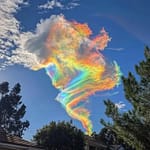Welcome to the fascinating world of cyclogenesis! 🌪️ Whether you’re a weather enthusiast or just curious about how storms form, this article will take you on a whirlwind tour of the science behind cyclones. Let’s dive in!
What is Cyclogenesis?
Cyclogenesis is the process by which a cyclone forms and develops. Think of it as the birth of a storm. This meteorological phenomenon involves the creation of a low-pressure area, which can lead to the formation of various types of cyclones, including tropical cyclones (like hurricanes) and extratropical cyclones.
The Ingredients for Cyclogenesis
Creating a cyclone is like baking a cake; you need the right ingredients. Here are the key components:
- Warm Ocean Waters: For tropical cyclones, sea surface temperatures need to be at least 26.5°C (about 80°F). This warmth provides the energy needed for the storm to develop.
- Atmospheric Instability: This occurs when warm, moist air rises and cools, causing condensation and cloud formation.
- Coriolis Effect: Due to Earth’s rotation, this effect helps to spin the storm. It’s why cyclones rotate differently in the Northern and Southern Hemispheres.
- Low Wind Shear: High wind shear can tear a developing storm apart. Low wind shear allows the storm to grow and organize.
The Stages of Cyclogenesis
- Formation: A disturbance, such as a tropical wave, interacts with the warm ocean water and begins to develop a low-pressure center.
- Development: The storm starts to organize, with thunderstorms forming around the low-pressure center. If conditions are right, it can develop into a tropical depression, then a tropical storm, and potentially a hurricane.
- Maturity: The cyclone reaches its peak intensity, characterized by a well-defined eye and strong winds.
- Dissipation: Eventually, the storm will weaken due to factors like land interaction, cooler waters, or high wind shear.
Fun Facts About Cyclones
- Cyclone Names: Did you know that cyclones are named alphabetically? Names are predetermined and alternate between male and female.
- Record Breakers: The strongest tropical cyclone ever recorded was Typhoon Tip in 1979, with a diameter of over 2,220 km (1,380 miles)!
- Cyclone vs. Hurricane vs. Typhoon: These terms all refer to the same weather phenomenon but are used in different regions. “Hurricane” is used in the Atlantic and Northeast Pacific, “typhoon” in the Northwest Pacific, and “cyclone” in the South Pacific and Indian Ocean.
Why Cyclogenesis Matters
Understanding cyclogenesis is crucial for predicting and preparing for storms. Accurate forecasts can save lives and minimize damage by providing early warnings and helping communities to prepare.
Learn More
For more in-depth information about cyclogenesis and other weather phenomena, check out the National Hurricane Center and the World Meteorological Organization.
- The MetOffice Cyclone Facts.
- National Hurricane Center USA.
- Homepage | World Meteorological Organization WMO.
Stay Tuned!
Keep visiting MM0ZIF Radio for more exciting articles on weather, science, and much more. Don’t forget to tune in to our latest broadcasts for real-time weather updates and expert insights.
Hi I am Marcus, MM0ZIF, a licenced Radio Amateur, Doctor of Musicology, amateur weather enthusiast. I over the years have been a Amateur Radio Tutor, Examiner, and a Regional Manager for the Radio Society of Great Britain.
This site is dedicated more towards Amateur Radio and Weather, with an angle on Technology too. I also maintain https://havenswell.com/ which is my other blog which is more aimed at cooking, hobbies and life in general as well as businness and networking.













